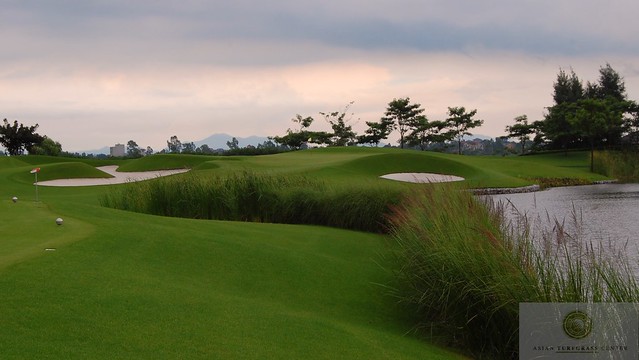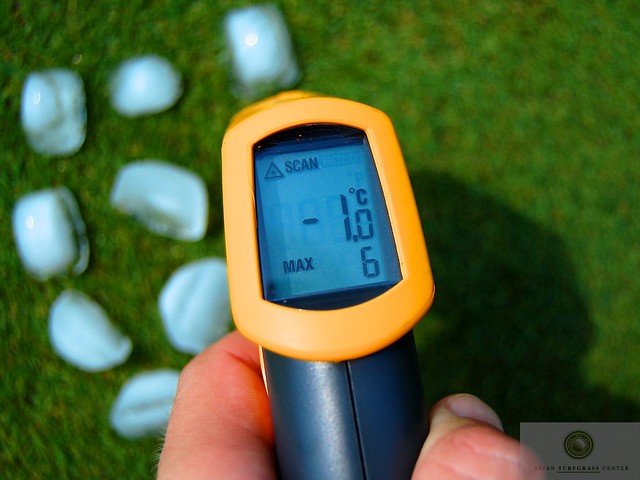Turf Diseases has moved to turfdiseases.org
No kind words for September

This time of year can be marked by extremes. The record lows are in the 40's, but there have been triple digit record highs almost all through September. Wild mood swings.
Fungicide trial
This year my PhD student Ken Obasa and I have been conducting a fungicide study on the putting green looking at a couple of fungicide programs, and a new product called Velista which should be released soon. All treatments are applied every two weeks. Velista is tested at 0.3 and 0.5 oz/1000. Here are the programs:
Program 1:
10 May Honor 1.1 oz
2 June Insignia SC .7 oz
17 June Spectro 90 5.75 oz
30 June Signature + Daconil 4 oz + 3.2 oz
14 July Insignia SC .7 oz
28 July Signature + Daconil 4 oz + 3.2 oz
11 Aug Chipco 26GT 4 oz
25 Aug Honor 1.1 oz
Program 2:
19 May Headway 3 oz
2 June Heritage TL 2 oz
17 June Spectro 90 5.75 oz
30 June Signature + Daconil 4 + 3.2 oz
14 July Heritage TL 2 oz
28 July Signature + Daconil 4 oz + 3.2 oz
11 Aug Chipco 26GT 4 oz
25 Aug Headway3 oz
Program 3:
19 May Disarm M 1 oz
2 June Disarm .36 oz
17 June Spectro 90 5.75 oz
30 June Signature + Daconil 4 + 3.2 oz
14 July Disarm .36 oz
28 July Signature + Daconil 4 + 3.2 oz
11 Aug Chipco 26GT 4 oz
25 Aug Disarm M 1 oz
Program 4:
19 May Tartan 2 oz
2 June Compass .25 oz
17 June Spectro 90 5.75 oz
30 June Signature + Daconil 4 + 3.2 oz
14 July Compass .25 oz
28 July Signature + Daconil 4 + 3.2 oz
11 Aug Chipco 26GT 4 oz
25 Aug Tartan 2 oz
We had a severe brown patch epidemic in early/mid August, and brown patch reached about 40% severity in the untreated plots. All the programs and the two Velista treatments held the disease to 0%.
Dollar spot pressure has been fairly low but with cooler temperatures I suspect it will flare up in the next week or two and probably though most of September. I’ll post some details later on.
.
.
Sun, Ice, and Climatological Normals
Is it Starting to Feel Like Groundhog Day?

So I bet many of you in the south are feeling like Bill Murray in the 1993 movie “Groundhog Day”. I know I am. Everyday we look at turfgrass samples with the same problem. Heat-related stress and decline and severe nematode populations! Many superintendents that I have spoken to are getting as frustrated as me. This heat is getting old. We are now sitting at 45 days above 100F here in Stillwater. In the Oklahoma City area they are knocking on the all-time record of 50 days! Everyday the same thing…
The OSU Turfgrass Diagnostic Laboratory has churned
 through a bunch of creeping bentgrass putting green samples in the last couple of weeks. The large bulk of samples have extremely short root systems. The heat has really taken its toll on creeping bentgrass in much of the south central U.S. Throw in some nematodes damaging what roots are left and we have a lot of turfgrass in serious decline. Very high populations of stunt (Tylenchorhynchus spp.) and ring (Criconemella ornata) nematodes have been observed in many of the samples submitted. We have seen populations of stunt nematodes as high as 4,000 individuals in 100 cc of soil. This is about 26 times the threshold we consider the “danger zone” on creeping bentgrass. Ring nematode populations have been coming in as high as 2,000 individuals per 100 cc soil, which is a
through a bunch of creeping bentgrass putting green samples in the last couple of weeks. The large bulk of samples have extremely short root systems. The heat has really taken its toll on creeping bentgrass in much of the south central U.S. Throw in some nematodes damaging what roots are left and we have a lot of turfgrass in serious decline. Very high populations of stunt (Tylenchorhynchus spp.) and ring (Criconemella ornata) nematodes have been observed in many of the samples submitted. We have seen populations of stunt nematodes as high as 4,000 individuals in 100 cc of soil. This is about 26 times the threshold we consider the “danger zone” on creeping bentgrass. Ring nematode populations have been coming in as high as 2,000 individuals per 100 cc soil, which is a bout four times the “danger zone” population level. So as you can see, things are getting tough here at the end of the summer in the south. Many are praying for cooler weather and rain. Although, those that have gotten rain have been struggling with wet greens and hot weather, which makes for a whole different set of hurdles.
bout four times the “danger zone” population level. So as you can see, things are getting tough here at the end of the summer in the south. Many are praying for cooler weather and rain. Although, those that have gotten rain have been struggling with wet greens and hot weather, which makes for a whole different set of hurdles.
Other issues in the diagnostic lab have been few and far between, but we did have one sample with Pythium root rot. This was an odd situation where the greens got dry and severe wilt began. To compensate the newly hired assistant superintendent turned the irrigation system on and severely over-irrigated multiple times. When you have lots of soil moisture and high temperatures in the rooting zone, Pythium root rot can help finish off the already declining plants. So while, not the initial cause of the problem, we did identify something other than nematodes. In our research plots, brown patch has also been active and dollar spot comes and goes pretty much as the humid weather comes and goes.
The long-term forecast is showing cooler temperatures, if we can just get through this weekend. As Dr. Kaminski has said in a previous post “there is light at the end of the tunnel.” So keep your head up and your fingers crossed for cooler temperatures, I think we will be there soon!
Greetings from Canada
Most of Canada has a much shorter season than in the States, but our superintendents are no strangers to a wide variety of diseases on their turf. This season has been a tough one for managers here in Ontario as we experienced a cool, wet spring followed by some of the hottest temperatures on record combined with prolonged periods of drought. Many turfgrass managers in the U.S. are used to excess heat and drought, but for most of Canada this kind of summer is very foreign to us. On the up side, the lack of moisture has kept a number of diseases at bay, but the turf (epecially the Poa annua) is suffering quite a bit from the prolonged stress. Fortunately, we are headed into the end of our summer as temperatures start to drop significantly by mid-August.
Major issues that we deal with here are dollar spot and anthracnose throughout the country, take-all patch and summer patch in Ontario as well as some of our prairie provinces (Alberta and Saskatchewan) due to very high soil pH levels, and plant-parasitic nematodes in British Columbia, the eastern provinces and here in Ontario. However, the diseases that we deal with the most in the colder provinces are the snow molds – both gray and pink.
I look forward to updating readers to goings on here in Canada based on discussions with superintendents and from the samples we receive in our diagnostic lab.
Good luck with the rest of the season!






















